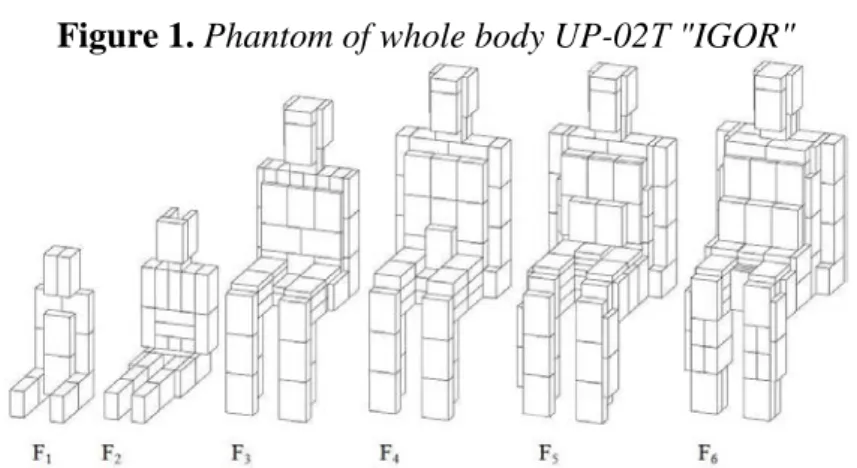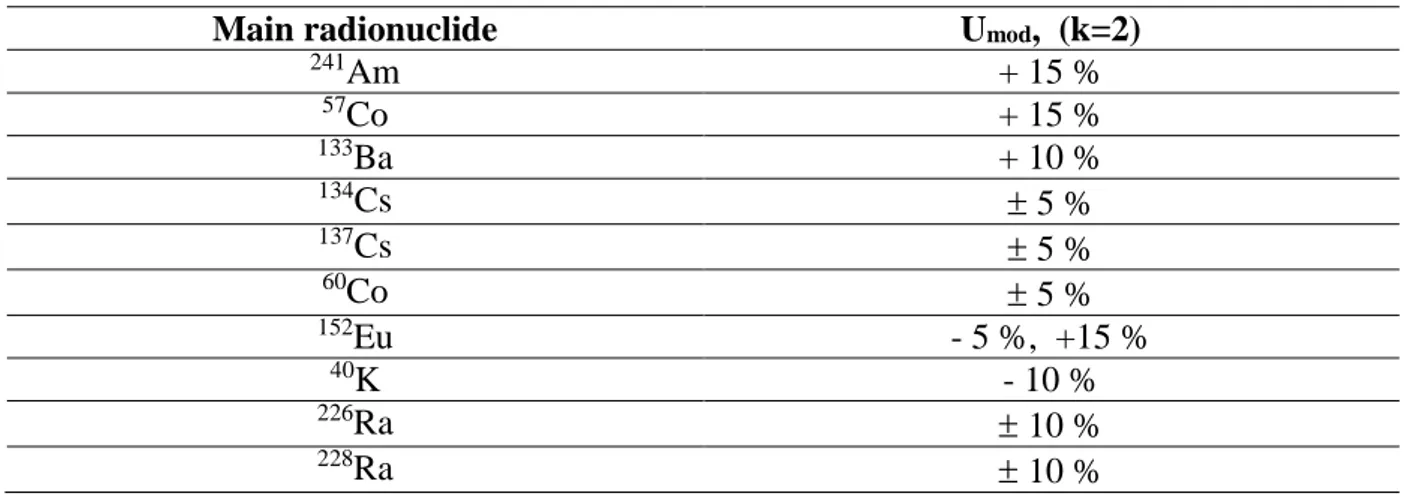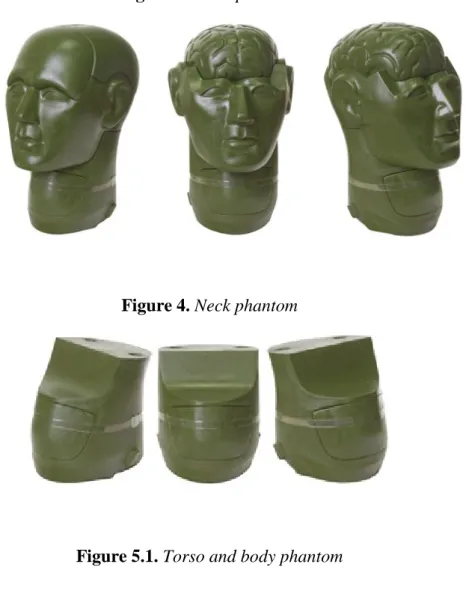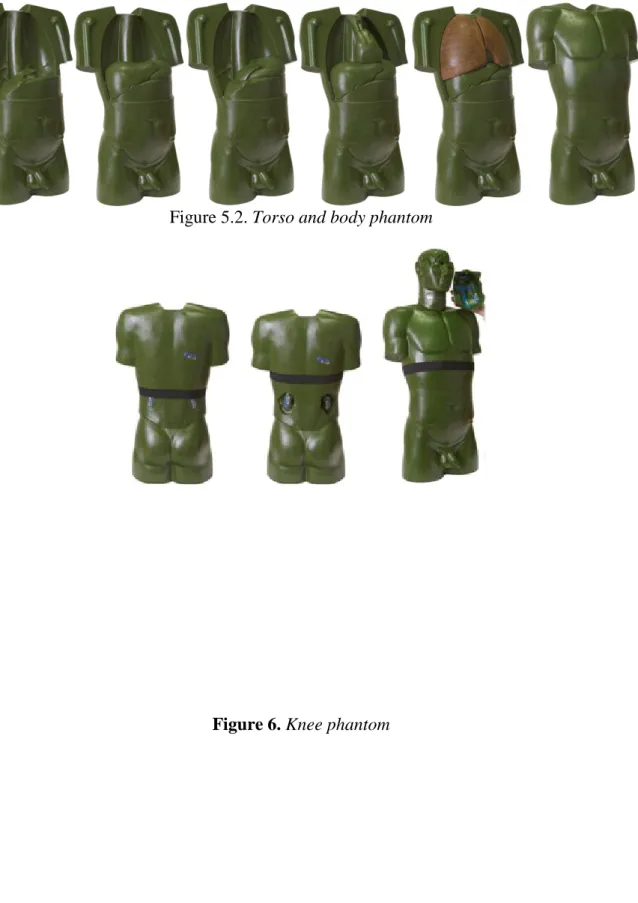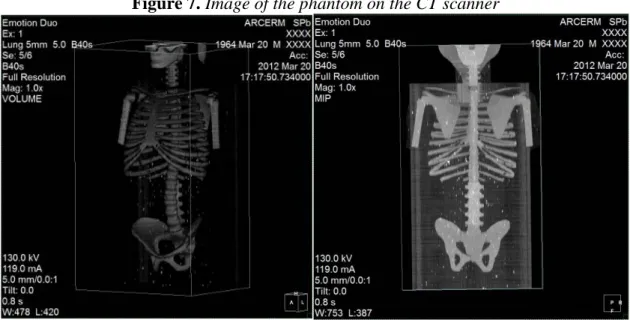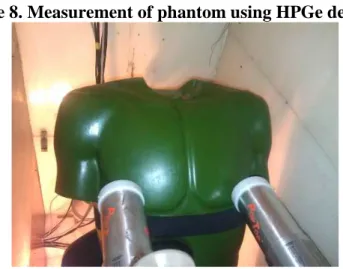BJRS
02-3A (2014) 01-12Experience of development and testing of a new model
of an anthropomorphic radiodosimetric phantom of
the human body ardf-10 «roman»
Bruhov R.E.
1, Finkel F.V.
21 STC RADEK, Russian Federation, Saint-Petersburg
Moskovsky av.19, b.3 +79211833099
bruxov@radek.ru
1 STC RADEK, Russian Federation, Saint-Petersburg
Moskovsky av.19, b.3 +79217894730
felix@radek.ru
ABSTRACT
In 2006-2010 by the commission of the Radiation and Nuclear Safety Authority in Finland applied scientific research and development of a new model of an anthropomorphic radiodosimetric phantom of the human body (the Phantom) were performed, after the development of the production technology and initial testing in 2010-2012 the first serial copy of the Phantom under the name ARDF-10 «ROMAN» was produced.
The main application of the new model of the Phantom ARDF-10 «ROMAN»:
- increase of the precision of calibration and implementation of the periodic monitoring of Whole body counters (WBC) equipment, standardization of measurement procedure for inter-laboratory comparisons of the incorporated activity.
- metrological support of the development and implementation of new methods for human radiation spectrometry: - identification of radionuclide content of incorporated activity in the human body;
- study of the mechanisms of the intake, distribution, accumulation and excretion of the radionuclides in the human body, such as:
- daughter products of 222Rn decay in the respiratory tract, 241Am, other transuranic elements;
- isotopes of iodine in the thyroid gland;
- radiopharmaceuticals administered to patients for diagnostic and medicinal purposes. - obtaining estimates of spatial-temporal distribution of individual internal exposure dose of a human.
The result of the work of recent years has been the creation of hygienic safe standard sample of an anthropomorphic radiodosimetric phantom of the human body ARDF-10 «ROMAN», consisting of 4 anthropometric models of body parts, which are independent assembly units (head phantom, neck phantom, torso phantom, knee phantom). Phantom models are made from simulators of bone, soft (muscle) and lungs biological tissue. The Phantom contains 28 separate elements. To the first Phantom model simulators of organs and body parts with incorporated radionuclides 241Am, 210Pb, 239Pu and U-natural are included. Also the background phantom without radionuclides is produced. Calibration
of WBC with planar detectors based on HPGe was performed, sample of persons exposed to the incorporated activity was studied.
1. INTRODUCTION
In 2006-2010 by the commission of the Radiation and Nuclear Safety Authority in Finland applied scientific research and development of a new model of an anthropomorphic radiodosimetric phantom of the human body (the Phantom) were performed.
After the development of the production technology and testing in 2010-2012 the first serial copy of the Phantom under the name ARDF-10 «ROMAN» was produced.
The main application of the new model of the phantom ARDF-10 «ROMAN»:
- calibration of Whole body counters (WBC) with increased accuracy, implementation of the periodic monitoring of WBC, standardization of measurement procedure for inter-laboratory comparisons of the incorporated activity.
- metrological support of the development and implementation of new methods for human radiation spectrometry:
- identification of radionuclide content of incorporated activity in the human body; - measurements of the activity of incorporated technogenic and natural radionuclides in
the whole body and in the lungs;
- study of the mechanisms of the intake, distribution, accumulation and excretion of the radionuclides in the human body, such as:
- daughter products of 222Rn decay in the respiratory tract, 241Am, other transuranic elements;
- isotopes of iodine in the thyroid body;
- radiopharmaceuticals administered to patients for diagnostic and medicinal purposes.
At the moment in Russian Federation three types of phantoms are widely used: - Unified phantom of the whole body UP-02T "IGOR";
- Phantom of the neck (thyroid body) FSCHZH-05; - Phantom of the chest FLT-02.
The most famous in Russian Federation as well as in the whole world is unified phantom UP-02T "IGOR" ([1], Fig.1), consisting of polyethylene blocks with slots, into which the rod sources of radioactive material are placed. Phantoms of a wide range of physiques - from a child 1-3 years old to adult men 18-45 years old, weighing 115 kg can be assembled from this blocks. Location of sources in the phantom blocks corresponds to a uniform distribution of radionuclides in the human body.
Figure 1. Phantom of whole body UP-02Т "IGOR"
The UP-02T phantom satisfactorily reproduces the spatial-energy gamma-ray spectrum of incor-porated radionuclides for transferring size of radionuclide activity to the whole body counter by its calibration in the energies range from 350 to 3000 keV. Advantages of UP-02T phantom asso-ciated with structural features (the ability to assemble phantoms sitting, standing-lying, child-teen-ager, adult, etc.), leak tightness and the wide range of rod radionuclide sources, offset by insuffi-cient to date adequacy of the model. Thus, the main uncertainty arising by the calibration of trometers includes three main components: the uncertainty caused by the instability of the spec-trometer over time (usually less than 3%), the uncertainty due to the quality of the used radionu-clide solution (uncertainty of source activity in the rods, no more than 5%) and the uncertainty related with incomplete adequacy of the used geometry and material of the phantom to the human body with uniformly distributed activity of the main radionuclide in it (uncertainty of modeling) and the absence of the bone tissue in the phantom. Table 1 shows the values of the expanded uncertainty of modeling for phantom UP-02T for some radionuclides.
Table 1.Expanded uncertainty of modeling for phantom UP-02T
Main radionuclide Umod, (k=2)
241Am + 15 % 57Co + 15 % 133Ba + 10 % 134Cs ± 5 % 137Cs ± 5 % 60Co ± 5 % 152Eu - 5 %, +15 % 40K - 10 % 226Ra ± 10 % 228Ra ± 10 %
To reduce uncertainty of modeling it was necessary to produce the more complex and adequate model of the phantom, and this task was performed. For ARDF-10 “ROMAN”phantom total un-certainties of modeling (anthropomorphism of geometry and material properties), and uncertainty of attestation of the reference radionuclide solution used in the manufacture of components, does
not exceed 5%. This fact made it possible to reduce the expanded uncertainty of the WBC calibra-tion from 3 to 6 times.
2. DESCRIPTION OF ARDF-10 «ROMAN» PHANTOM
ARDF-10 «ROMAN» phantom consists of 4 anthropometric models of body parts, which are in-dependent assembly units (head phantom, neck phantom, human torso phantom, knee phantom). See Figure 3, 4, 5 and 6.
Figure 3. Head phantom
Figure 4. Neck phantom
Figure 5.2. Torso and body phantom
Head phantom consists of 5 separate products (frontal bone with the soft tissue, two parietal bones with soft tissue, brain, base of skull with facial bones, including face soft tissue). The brain can be integrated with the base of skull (glued).
Neck phantom consists of 3 separate products (body of larynx, thyroid body, soft tissues of the neck with cervical spine).
Body/torso phantom models thoracic, lumbar, pelvic-abdominal body parts and consists of 14 sep-arate products (the base of body, soft tissue of chest with the front of the rib shirts, skeleton, left and right lung, heart, liver, stomach, left and right kidney, soft tissue of left and right kidney, soft tissue of abdomen, simulator of pancreas with connective tissue, the total tissue of the esophagus, trachea, aorta, vena cava).
Knee phantom consists of 6 detachable products (muscles tissue, front and back, half of the thigh bone, half of the cannon bones, knee cap, soft tissue of the knee cap).
Phantom ARDF-10 «ROMAN» is made as a model of the adult men body 18 to 20 years old (in the pose of standing and lying) with the body parameters recommended by the ICRP [2] and corresponding to the atlas of human anatomy. [3]
The composition of the simulated biological tissues is in accordance with ICRU recommenda-tions [2, 4]. As the simulated tissue of the skeleton averaged bone tissue (bone biological tissue - BBT) consisting of: bone (53.7%), cartilage (10.7%), red bone marrow (1.4%), yellow bone mar-row (24.2%) at an average density ρ = 1,3 g/cm3 was adopted. As the simulated soft biological
at a tissue density ρ = 0,26 g/cm3 was adopted.
Materials for the manufacture of component parts of the phantom are plastic materials composi-tions based on epoxy resin with fillers. The components of the composition are epoxy resin as a binding base, hardener, as a regulator of curing speed, plasticizer, as a regulator of plasticity, chro-mium oxide III (Cr2O3), calcium carbonate, as a regulator of a the mass attenuation coefficient, the
microspheres, as a regulator of density, starch as a thickener and uniformity regulator, chromium oxide III (Cr2O3), ion exchange resin, as carriers of the radionuclide.
The listed materials composition provides tissue-equivalence of plastic-imitators to bone, soft and pulmonary biology tissues of the total deviation no more than 3% for the energies range from 17 to 60 keV, which according to the recommendations of the ICRU [5], is sufficient for radiometric and dosimetric phantoms.
3. CALIBRATION OF WBC FOR LOCALIZATION OF RADIONUCLIDES
IN INDIVIDUAL ORGANS AND TISSUES
The main practical purpose of spectrometry and radiometry of human radiation is the reduction of radiation exposure on the monitored contingent, who operates nuclear facilities, as well as the population exposed to radiation from natural sources. Economic purpose is reducing the cost of medical care.
In this field one of the important contemporary issues is the study of mechanisms of intake, distribution, accumulation and excretion of radon and its daughter products through the respiratory system. It is known [6] that the global average annual effective dose of internal exposure due to inhalation of radon is 1,2 mSv, and in areas with high natural emanation this value is up to 30 mSv / year.
To solve these problem the use of calibrated, high-precision whole body counters, providing the necessary and sufficient measurements characteristics (time, financial and labor costs, precision) is necessary. Calibration performance provides for availability of radionuclide phantom models of organs and body parts, for example the lungs, trachea, pharynx, placed in the background models
of the head, neck and torso. The only solution to this problem is a collapsible phantom, which consists of a radionuclide and background elements.
Another, well-known problem associated with internal exposure, is the problem of radioactive strontium. 90Sr radionuclide belongs to biologically significant bone-seeking radionuclides and is highly toxic. Its significance for the population is related with the possibility of intake of this radionuclide from foods. Radioactive strontium selectively accumulates in bone tissue mainly of children during the development of their skeleton. With a large period of the biological half-life (~ 50 years), high boundary energies of β-spectra, 90Sr exposes the stem cells of the red bone
marrow with large doses of radiation. From the total amount of this radionuclide, containing in the human body, more than 99% is in the bones. The problem of measuring the content of 90Sr in human body becomes more complicated due to fact that it, as well as its daughter products 90Y, is a “pure” β-emitter. Using effect of gamma radiation bremsstrahlung it is possible to measure the content of 90Sr in the human body by means of ordinary whole body counters. These spectrometers can be calibrated using a background set of ARDF-10 "ROMAN" phantom, containing a skeleton made of bone tissue imitator with a known incorporated activity of 90Sr. Manufacturing technology of phantoms has been developed and applied.
on spectrometric equipment, and as a consequence, there is a frequent need to calibrate such equip-ment for various radionuclides in different localizations.
Measurement of transuranic elements: isotopes of uranium, plutonium, 241Am and other radionuclides with low energy (less than 250 keV) of photon radiation in the lungs is highly relevant, due to their high radiation exposure on the pulmonary tissue. Also, it is necessary to control the content of 137Cs in the whole body, 90Sr in bone tissue, isotopes of iodine in the thyroid
body using detection systems of positional or scanning type.
4. TEST MEASUREMENTS AND CALIBRATIONS
To test the applicability of the ARDF-10 phantom a series of calibrations of whole body counters were performed. As an example, consider the complex of human radiation spectrometry, built in the Institute of Industrial Medicine, which in addition to the six scintillation tracts, contains two planar HPGe detectors (GLP-36360/13P4 ORTEC production) placed in a large low-background chamber (cast iron of pre nuclear age 150 mm, lead 10 mm, copper, cadmium, organic glass), see Fig. 8.
Table 2 shows the minimum measured activity (MMA) for the measurement time 1 hour and the minimum detectable activity (MDA) for the measurement time 10 minutes. During calibration radionuclide elements of phantom were used, such as:
- knee-cap with radionuclide U-nat;
- joint knee with radionuclides U-nat and 210Pb; - frontal bone with radionuclides U-nat and 210Pb;
Figure 8. Measurement of phantom using HPGe detectors
Table 2. WBC calibration results using ARDF-10 «ROMAN» phantom Geometry Ra- dio- nu-clide Е, keV Intensity from phantom, s-1 A, Bq on 01.08.2012 Effi-ciency, s -1∙Bq-1 MMA, Bq (T=1h, U=50%) MDA, Bq (T=10min) Frontal bone 210Pb 46,5 10,6 19600 0,0135 1,0 1,2
Frontal bone U-nat 63,3 3,47 6750 0,0115 0,9 1,0
185,7 1,42 0,00039 30 36 Knee U-nat 63,3 3,46 29700 0,0026 3,6 4,4 185,7 1,71 0,00011 100 130 Knee 210Pb 46,5 3,64 33630 0,0027 5,0 6,1 Lungs 241Am 59,5 13,2 43090 0,00085 11 14
5. CONCLUSIONS
The result of the recent years work has been the creation of hygienic safe reference sample of anthropomorphic radiodosimetric human body phantom ARDF-10 «ROMAN», consisting of 4 anthropometric models of body parts, which are independent assembly units (head phantom, neck phantom, torso phantom, knee phantom). Phantom models are made from imitators of bone, soft (muscle) and pulmonary biological tissues. Phantom consists of 28 separate elements. To the first phantom model simulators of organs and body parts with incorporated radionuclides 241Am, 210Pb, 239Pu and U-nat are included. Also the background phantom without radionuclides is made. The
calibration of WBC with planar detectors based on HPGe and other equipment, sample of persons exposed to the incorporated activity were performed.
REFERENCES
1. ICRU REPORT 48-1993 Phantoms and computational models in therapy diagnosis and protection.
2. Basic Anatomical and Physiological Data for Use in Radiological Protection: Reference Values. ICRP, Publication 89, 2003.
3. R.D.Sinelnikov. Atlas of Human Anatomy. V. 1, 2, 3 M.,“Medicine”, 1978. (in Russian).
4. Basic Anatomical and Physiological Data for Use in Radiological Protection. The Skeleton. ICRU, Publication 70, 1995.
5. Tissue Substitutes in Radiation Dosimetry and Samplement. ICRU Report 44, 1989. Bethesda, Maryland, U.S.A.
6. "Sources of radiation" http://chornobyl.in.ua/istochniki-obluchenia.html (in Russian). 7. I. Y. Vasilenko, "Radioactive strontium", State Scientific Center — Institute of Biophysics. http://nuclphys.sinp.msu.ru/ecology/isotopes/Strontium.pdf (in Russian).
